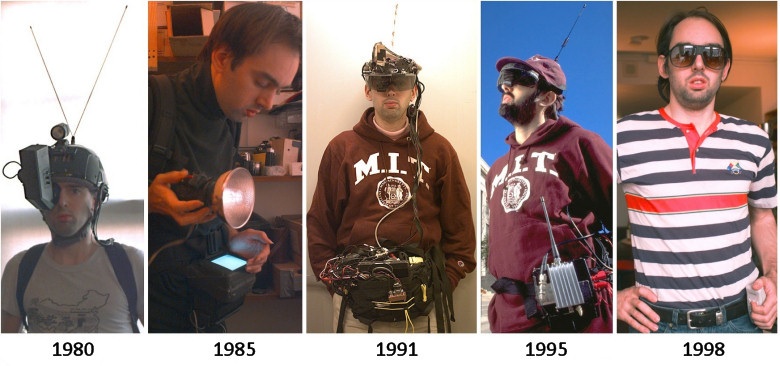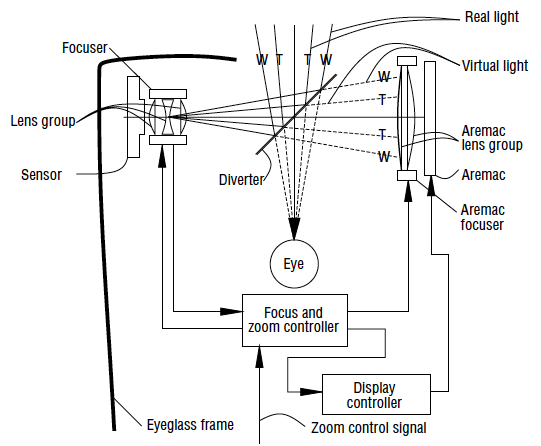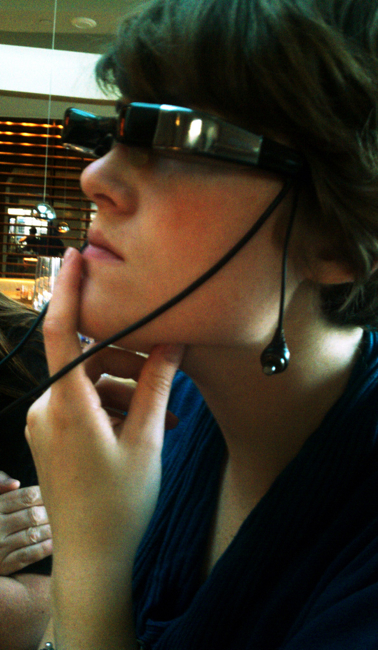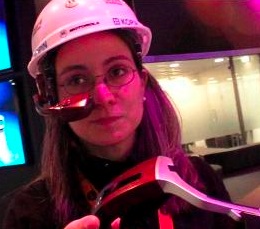Wearable Computing
Contents
[hide]Definition
"Wearable computing facilitates a new form of human--computer interaction comprising a small body--worn computer (e.g. user--programmable device) that is always on and always ready and accessible. In this regard, the new computational framework differs from that of hand held devices, laptop computers and personal digital assistants (PDAs). The ``always ready capability leads to a new form of synergy between human and computer, characterized by long-term adaptation through constancy of user--interface.
A wearable computer is a computer that is subsumed into the personal space of the user, controlled by the user, and has both operational and interactional constancy, i.e. is always on and always accessible. Most notably, it is a device that is always with the user, and into which the user can always enter commands and execute a set of such entered commands, and in which the user can do so while walking around or doing other activities" [1].
Modern Wearable Computing
Although the Internet is invisible and seemingly omnipresent, it is only accessible by two-dimensional interfaces on physical machines in connected fields. It has only been a recent occurrence that we’ve been able to carry around complex computational interfaces in our pockets, increasing technological capabilities into our everyday lives. Until this point, one had to be in a certain time and place in order to access computing power. This usually meant a college or university, and sometimes between the hours of 3 and 6 Am.
History

The first person to pioneer the idea of being able to compute anywhere and be connected was Steven Mann, the inventor of Wearable computing. He thought that humans should not contort to computers, but that computers should contort to humans. He wore 80 pounds of computing equipment, including a wireless uplink to an early manifestation of the Internet (MITs local Internet) starting in 1979. As time progressed, computing became lighter, and Steve Mann’s load became less burdensome while still retaining the same functionality. Similarly, computers have jumped from gymnasiums to desktops to pockets.
Steve Mann envisioned a future in which hardware could be downloaded in as easily as software. Where one’s contact lens prescription could change during the day based on one’s needs. A future where a device morphs is the most fluid and liquid that an interface can become. Interfaces today are limited by their external structure. This limitation will dissolve when the hardware dissolves.
Examples
WearCam: The Wearable Camera
Developed by Steve Mann WearCam Dr. Mann's WearComp invention dates back to his high school days in the 1970s and early 1980s, where he was experimenting with wearable computing and personal imaging as a personal hobby. http://wearcam.org/mcluhan-keynote.htm
Evolution of WearCam
"Due to recent advances in miniaturization, the author's "wearable computer" invention of the late 1970s and early 1980s, comprising a backpack-based, tetherless computer system together with wireless communications, has been transformed from an awkward and cumbersome burden into a completely unobtrusive internet-connected multimedia computer built within an ordinary pair of eyeglasses and ordinary clothing. This transformation allows it to be worn constantly, with the goal of becoming a seamless extension of the body and mind. In addition to replacing one's cellular telephone, personal music system, dictating machine, pager, camcorder, laptop computer, PDA, and the like, with a single well-integrated unit, the apparatus can perform new and previously unexpected useful functions" [2].
EyeTap

Definition
EyeTap is a device which allows, in a sense, the eye itself to function as both a display and a camera. EyeTap is at once the eye piece that displays computer information to the user and a device which allows the computer to process and possibly alter what the user sees. That which the user looks at is processed by the EyeTap. This allows the EyeTap to, under computer control, augment, diminish, or otherwise alter a user's visual perception of their environment, which creates a Computer Mediated Reality. Furthermore, ideally, EyeTap displays computer-generated information at the appropriate focal distance, and tonal range. The figure below depicts and describes the basic functional principle of EyeTap. Note from the diagram that the rays of light from the environment are collinear with the rays of light entering the eye (denoted by the dotted lines) which are generated by a device known as the aremac. "aremac" is the word camera spelled backwards and is the device which generates a synthetic ray of light which is collinear with an incoming ray of light. Ideally, the aremac will generate rays of light to form an image which appears to be spatially aligned, and appears at with the same focus as the real world scene [3].
Fundamental operating principle of EyeTap
Rays of light which would have otherwise entered the eye are instead reflected by the diverter. The diverter is typically a double-sided mirror or a beamsplitter. These rays of light are collected by a sensor, typically a CCD camera. This camera data is processed, and the aremac redisplays the image as rays of light. The aremac (the word `camera' backwards), is a display device which is capable of displaying information at an appropriate depth. These rays reflect again off the diverter, and are then collinear with the rays of light from the scene. Thus the rays of light hitting the sceneward side of the diverter in a sense "pass through" the diverter by passing through the processor and aremac. The user perceives the virtual light. This virtual light can be either the same image, or a computer mediated version of the real world scene, since the virtual light is altered under computer control [4].
MyVu Video Camera Glasses

MyVu (formerly MicroOptical) is a maker of mass market personal video goggles that are priced under $200 a pair. They're marketed as personal video viewers for iPods and other video players vs. being actual wearable computers.

Monocular Displays
Monocular displays like Steve Mann and Thad Starner wear are still in the thousands of dollars and are generally used by the military.
Head-Mounted Computers and Displays
Example head-mounted 15" display with an information-aware display. The system features six-axis position tracker from Hillcrest Labs that allows one to operate a cursor with nearly pixel-for-pixel accuracy by just moving around your head when for example panning around a large image or a map. There is a highly targetted microphone that understands voice-commands where that allow one to zoom in on maps or images, launch specific applications, and open specific files.
Hardware Specifications
- Second Generation Kopin Golden-i Motorola-branded Head-mounted Computer system
- Processor: TI OMAP3530 clocked at 600MHz
- Display: Kopin SVGA (800 x 600) liquid crystal micro display (LCD)
- Networking: Bluetooth 2.0 WiFi
- User interface: Includes speech recognition and motion sensing
- Other: I/O -- 1 x USB Expansion -- microSD slot
- Power: 1200 mAh battery provides more than eight hours of operation Weight -- 3 oz (85g)
- Operating system: Windows CE
Future of Wearable Computers
The whole of the Internet is an invisible, 4th dimensional potentiality with portals of different sizes, shapes, and capabilities. The hardware determines the size of the portal, the connection determines the rate of information flow, and the software/web browser and the sites within that web browser determine the rate of information absorption into the mind. The rate of information absorption is dependant upon the format of the information presented. Wearable Computers will evaporate over time until they are no longer noticeable or are proper ubiquitous extensions of the self, as valuable and as iconic as sports cars and external transport structures for the physical body.
Wearable Computing Laboratories
Additional Reading
External Links
- Wearablerable, tetherless computer--mediated reality: WearCam as a wearable face--recognizer, and other applications for the disabled by Steve Mann
- Wearable Computing as means for Personal Empowerment, Keynote Address for The First International Conference on Wearable Computing, ICWC-98, May 12-13, Fairfax VA by Steve Mann, University of Toronto.
- Smart Clothes: The MIT Wearable Computing Web Page
- Wearable Computing: Toward Humanistic Intelligence
